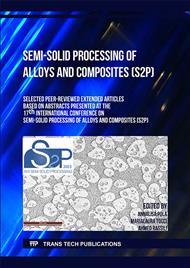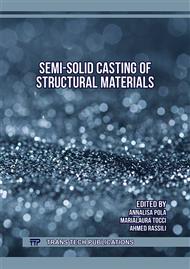p.3
p.11
p.17
p.23
p.31
p.39
p.47
p.53
Heat-Treatment Characteristics and Structure-Property Relationships of Thixomolded AZ91 and Ultralight LAZ771 Magnesium Alloys
Abstract:
Most magnesium alloys are produced by die casting due to their formability issues, but the thixomolding process has recently drawn considerable attention in manufacturing magnesium alloy casings for 3C electronic devices with lower porosity levels. This study compared the mechanical properties and microstructure of thixomolded AZ91 and ultra-light LAZ771 magnesium alloy for thin laptop cases. The experimental results firstly show that the microstructure of as-thixomolded samples contains fine αMg grains and a divorced eutectic network. After solution heat treatment, the ductility is improved due to the dissolution of the non-equilibrium secondary phases. Secondly, microstructural characterization for samples after aging treatment shows that the Mg17Al12 precipitates in AZ91 can be classified into continuous (CPs) and discontinuous precipitates (DPs) according to their morphologies. On the other hand, the AlLi precipitates in LAZ771 after aging treatment are spherical and incoherent with the αMg matrix. Those AlLi precipitates obstruct basal slip of dislocations in αMg matrix more effectively than Mg17Al12, resulting in higher yield strength of peak-aged LAZ771 specimens than heat-treated AZ91 specimens.
Info:
Periodical:
Pages:
11-16
Citation:
Online since:
August 2023
Authors:
Price:
Сopyright:
© 2023 Trans Tech Publications Ltd. All Rights Reserved
Share:
Citation:



